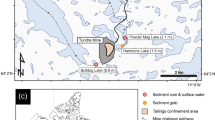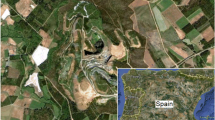Abstract
Purpose
Resuspension of sediment derived from natural and anthropogenic processes in surface waters may induce the release of metals, nutrients and other undesirable constituents from sediment to the water column. Characterizing the effects of sediment resuspension under variable geochemical conditions is important for predicting and mitigating contaminant releases during potential dredging operations, as metal(loid) transport may differ under oxidizing and reducing conditions.
Materials and methods
Lake sediment core samples containing elevated concentrations of mercury, other metal(loid)s and nutrients were physically and chemically characterized. Speciation analyses using sequential extraction and synchrotron radiation-based X-ray absorption spectroscopy methods were used to investigate the chemical form and distribution of mercury and other metal(loid)s. The sediment samples were subjected to resuspension under oxic and anoxic conditions to isolate the effects of air entrainment on contaminant release.
Results and discussion
Sequential extraction analyses suggested that the mercury was present primarily in moderately to strongly bound forms, such as mercury-organo chelates and mercury sulphides, whereas only trace amounts were found as less bound forms of mercury. Synchrotron-based micro-X-ray absorption near-edge structure (μ-XANES) and micro-X-ray fluorescence (μ-XRF) spectroscopy analyses suggested the presence of mercury oxide, mercury sulphide and copper sulphide phases. Higher aqueous metal(loid) and nutrient releases were observed under oxic resuspension conditions compared to anoxic conditions.
Conclusions
Higher releases of some constituents under oxic mixing conditions potentially were due to the oxidation of organic matter and/or sulphide mineral phases. These results suggest that resuspension tests performed under variably oxygenated conditions may provide a useful analytical tool for isolating the effect of air entrainment on contaminant release.








Similar content being viewed by others
References
Beachler MM, Hill DF (2003) Stirring up trouble? Resuspension of bottom sediments by recreational watercraft. Lake Reserv Manag 19:15–25
Bloesch J (1995) Mechanisms, measurement and importance of sediment resuspension in lakes. Mar Freshw Res 46:295–304
Bloom NS, Preus E, Katon J, Hiltner M (2003) Selective extractions to assess the biogeochemically relevant fractionation of inorganic mercury in sediments and soils. Anal Chim Acta 479:233–248
Brassard P, Kramer JR, Collins PV (1997) Dissolved metal concentrations in suspended sediment in Hamilton Harbour. J Great Lakes Res 23:86–96
Charnock JM, Moyes LN, Pattrick RAD, Mosselmans JFW, Vaughan DJ, Livens FR (2003) The structural evolution of mercury sulfide precipitate: an XAS and XRD study. Am Mineral 88:1197–1203
Churchill JH (1989) The effect of commercial trawling on sediment resuspension and transport over the Middle Atlantic Bight continental shelf. Cont Shelf Res 9:841–864
Clarke TL, Lesht B, Young RA, Swift DJP, Freeland GL (1982) Sediment resuspension by surface-wave action: an examination of possible mechanisms. Mar Geol 49:43–59
Corbett DR (2010) Resuspension and estuarine nutrient cycling: insights from the Neuse River Estuary. Biogeosciences 7:3289–3300
Correll DL (1998) The role of phosphorus in the eutrophication of receiving waters: a review. J Environ Qual 27:261–266
Davis WR (1993) The role of bioturbation in sediment resuspension and its interaction with physical shearing. J Exp Mar Biol Ecol 171:187–200
De Vicente I, Cruz-Pizarro L, Rueda FJ (2010) Sediment resuspension in two adjacent shallow coastal lakes: controlling factors and consequences on phosphate dynamics. Aquat Sci 72:21–31
Engler RM, Patrick WH Jr (1975) Stability of sulfides of manganese, iron, zinc, copper, and mercury in flooded and nonflooded soil. Soil Sci 119:217–221
Flemming BW (2000) A revised textural classification of gravel-free muddy sediments on the basis of ternary diagrams. Cont Shelf Res 20:1125–1137
Gibson BD, Ptacek CJ, Lindsay MBJ, Blowes DW (2011) Examining mechanisms of groundwater Hg(II) treatment by reactive materials: an EXAFS study. Environ Sci Technol 45:10415–10421
Gibson BD, Blowes DW, Lindsay MBJ, Ptacek CJ (2012) Mechanistic investigations of Se(VI) treatment in anoxic groundwater using granular iron and organic carbon: an EXAFS study. J Hazard Mater 241–242:92–100
Hartley W, Dickinson NM (2010) Exposure of an anoxic and contaminated canal sediment: mobility of metal(loid)s. Environ Pollut 158:649–657
Havens KE (1991) Fish-induced sediment resuspension: effects on phytoplankton biomass and community structure in a shallow hypereutrophic lake. J Plankton Res 13:1163–1176
Havens KE, Aumen NG, James RT, Smith VH (1996) Rapid ecological changes in a large subtropical lake undergoing cultural eutrophication. Ambio 25:150–155
Hellström T (1991) The effect of resuspension on algal production in a shallow lake. Hydrobiologia 213:183–190
Holley EA, McQuillan AJ, Craw D, Kim JP, Sander SG (2007) Mercury mobilization by oxidative dissolution of cinnabar (α-HgS) and metacinnabar (β-HgS). Chem Geol 240:313–325
Holmroos H, Hietanen S, Niemistö J, Horppila J (2012) Sediment resuspension and denitrification affect the nitrogen to phosphorus ratio of shallow lake waters. Fundam Appl Limnol 180(3):193–205
Horowitz A (1985) A primer on trace metal-sediment chemistry. U.S. Geological Survey Water Supply Paper 2277. U.S. Government Printing Office, Washington, 67 pp
Hwang K-Y, Kim H-S, Hwang I (2011) Effect of resuspension on the release of heavy metals and water chemistry in anoxic and oxic sediments. Clean Soil Water Air 39:908–915
Khorasanipour M, Tangestani MH, Naseh R (2012) Application of multivariate statistical methods to indicate the origin and geochemical behavior of potentially hazardous elements in sediment around the Sarcheshmeh copper mine, SE Iran. Environ Earth Sci 66:589–605
Kim CS, Rytuba JJ, Brown GE Jr (2004a) EXAFS study of mercury(II) sorption to Fe- and Al-(hydr)oxides I. Effects of pH. J Colloid Interface Sci 271:1–15
Kim CS, Rytuba JJ, Brown GE Jr (2004b) EXAFS study of mercury(II) sorption to Fe- and Al-(hydr)oxides II. Effects of chloride and sulfate. J Colloid Interface Sci 270:9–20
Kristensen P, Søndergaard M, Jeppesen E (1992) Resuspension in a shallow eutrophic lake. Hydrobiologia 228:101–109
Kristensen E, Ahmed SI, Devol AH (1995) Aerobic and anaerobic decomposition of organic matter in marine sediment: which is fastest? Limnol Oceanogr 40:1430–1437
Legros S, Chaurand P, Rose J, Masion A, Briois V, Ferrasse J-H, Macary HS, Bottero J-Y, Doelsch E (2010) Investigation of copper speciation in pig slurry by a multitechnique approach. Environ Sci Technol 44:6926–6932
Manceau A, Nagy KL (2008) Relationships between Hg(II)-S bond distance and Hg(II) coordination in thiolates. Dalton Trans 11:1421–1425
Martino M, Turner A, Nimmo M, Millward GE (2002) Resuspension, reactivity and recycling of trace metals in the Mersey Estuary, UK. Mar Chem 77:171–186
Marvin-DiPasquale M, Cox MH (2007) Legacy mercury in Alviso slough, South San Francisco Bay, California: concentration, speciation and mobility. US Geological Survey Open-File Report 2007–1240, 98p
Marvin-DiPasquale M, Alpers CN, Fleck JA (2009) Mercury, methylmercury, and other constituents in sediment and water from seasonal and permanent wetlands in the Cache Creek settling basin and Yolo Bypass, Yolo County, California, 2005–06. US Geological Survey Open File Report 2009–1182, 69p
Marvin-DiPasquale M, Agee JL, Kakouros E, Kieu LH, Fleck JA, Alpers CN (2011) The effects of sediment and mercury mobilization in the South Yuba Rover and Humbug Creek confluence area, Nevada County, California: concentrations, speciation and environmental fate—part 2: laboratory experiments. US Geological Survey Open-File Report 2010–1325B, 53p
Messieh SN, Rowell TW, Peer DL, Cranford PJ (1991) The effects of trawling, dredging and ocean dumping on the eastern Canadian continental shelf seabed. Cont Shelf Res 11:1237–1263
Mucci A, Lucotte M, Montgomery S, Plourde Y, Pichet P, Van Tra H (1995) Mercury remobilization from flooded soils in a hydroelectric reservoir of northern Quebec, La Grande-2: results of a soil resuspension experiment. Can J Fish Aquat Sci 52:2507–2517
Nordstrom DK (1977) Thermochemical redox equilibria of ZoBell’s solution. Geochim Cosmochim Acta 41(12):1835–1841
Parkman RH, Charnock JM, Bryan ND, Livens FR, Vaughan DJ (1999) Reaction of copper and cadmium ion in aqueous solution with goethite, lepidocrocite, mackinawite, and pyrite. Am Mineral 84:407–419
Pattrick RAD, Mosselmans JFW, Charnock JM, England KER, Helz GR, Garner CD, Vaughan DJ (1997) The structure of amorphous copper sulfide precipitates: an X-ray absorption study. Geochim Cosmochim Acta 61:2023–2036
Paul MC, Toia RF, von Nagy-Felsobuki EI (2003) A novel method for the determination of mercury and selenium in shark tissue using high-resolution inductively coupled plasma-mass spectrometry. Spectrochim Acta Part B 58:1687–1697
Ravel B, Newville M (2005) ATHENA, ARTEMIS, HEPHAESTUS: data analysis for X-ray absorption spectroscopy using IFEFFIT. J Synchrotron Radiat 12:537–541
Reed DC, Slomp CP, Gustafsson BG (2011) Seidmentary phosphorus dynamics and the evolution of bottom-water hypoxia: a coupled benthic-pelagic model of a coastal system. Limnol Oceanogr 56:1075–1092
Schelske CL, Carrick HJ, Aldridge FJ (1995) Can wind-induced resuspension of meroplankton affect phytoplankton dynamics? J N Am Benthol Soc 14:616–630
Simpson SL, Rosner J, Ellis J (2000) Competitive displacement reactions of cadmium, copper, and zinc added to a polluted, sulfidic estuarine sediment. Environ Toxicol Chem 19:1992–1999
Skyllberg UL, Bloom PR, Qian J, Lin C-M, Bleam WF (2006) Complexation of mercury(II) in soil organic matter: EXAFS evidence for linear two-coordination with reduced sulfur groups. Environ Sci Technol 40:4174–4180
Slowey AJ (2010) Rate of formation and dissolution of mercury sulfide nanoparticles: the dual role of natural organic matter. Geochim Cosmochim Acta 74:4693–4708
Slowey AJ, Brown GE Jr (2007) Transformations of mercury, iron, and sulfur during the reductive dissolution of iron oxyhydroxide by sulfide. Geochim Cosmochim Acta 71:877–894
U.S. EPA (1996) Evaluation of dredged material proposed for discharge in waters of the U.S. – Testing Manual. EPA/823/B-98/004
U.S. EPA (2002) Method 1631, Revision E. Mercury in water by oxidation, purge and trap, and cold vapor atomic fluorescence spectrometry. EPA/821/R-02/019
Vicinie A, Palermo M, Matko L (2011) A review of the applicability of various elutriate tests and refinements of these methodologies. In: Proceedings, WEDA XXXI Technical Conference & TAMU 42 Dredging Seminar, June 5-8, Nashville, TN, USA
Walker WW Jr, Havens KE (1995) Relating algal bloom frequencies to phosphorus concentrations in Lake Okeechobee. Lake Reserv Manag 11:77–83
Wolfenden S, Charnock JM, Hilton J, Livens FR, Vaughan DJ (2005) Sulfide species as a sink for mercury in lake sediments. Environ Sci Technol 39:6644–6648
Xia K, Skyllberg UL, Bleam WF, Bloom PR, Nater EA, Helmke PA (1999) X-ray absorption spectroscopic evidence for the complexation of Hg(II) by reduced sulfur in soil humic substances. Environ Sci Technol 33:257–261
Ye S, Laws EA, Gambrell R (2013) Trace element remobilization following the resuspension of sediments under controlled redox conditions: City Park Lake, Baton Rouge, LA. Appl Geochem 28:91–99
Acknowledgments
This study was made possible by funding through the Natural Science and Engineering Research Council of Canada. Synchrotron-based techniques were performed at GeoSoilEnviroCARS (Sector 13), Advanced Photon Source (APS), Argonne National Laboratory. GeoSoilEnviroCARS is supported by the National Science Foundation—Earth Sciences (EAR-0622171) and Department of Energy—Geosciences (DE-FG02-94ER14466) divisions. Use of the Advanced Photon Source was supported by the US Department of Energy, Office of Science, Office of Basic Energy Sciences, under Contract No. DE-AC02-06CH11357. We thank Dr. M. Newville and Dr. Y. Choi for their assistance at the beamline, and Melissa Holingham and Alan Fan for their assistance with the experimental work.
Author information
Authors and Affiliations
Corresponding author
Additional information
Responsible editor: Kimberley N. Irvine
Rights and permissions
About this article
Cite this article
Gibson, B.D., Ptacek, C.J., Blowes, D.W. et al. Sediment resuspension under variable geochemical conditions and implications for contaminant release. J Soils Sediments 15, 1644–1656 (2015). https://doi.org/10.1007/s11368-015-1106-6
Received:
Accepted:
Published:
Issue Date:
DOI: https://doi.org/10.1007/s11368-015-1106-6




